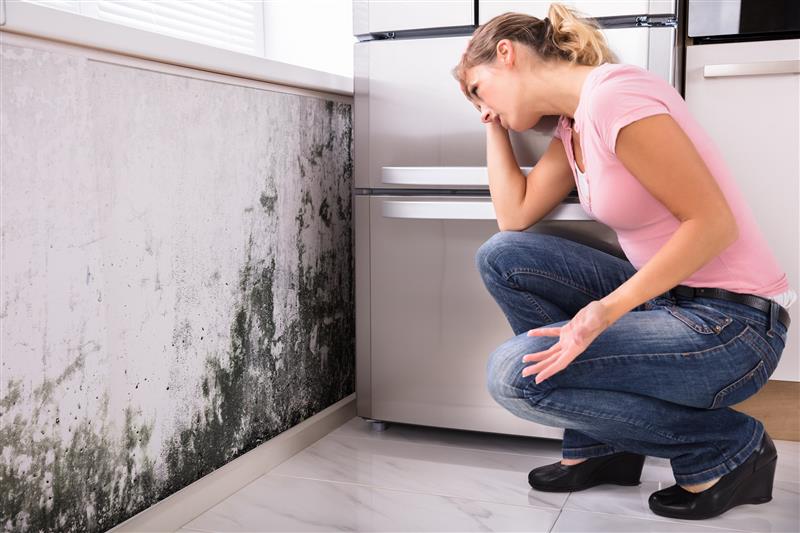Within 24 to 48 hours following flooding or water damage, mold can begin to grow on walls. In addition to causing damage to your property, mold can cause allergies, respiratory disorders, and chronic respiratory problems. Ignoring it can worsen the issue and increase the cost of future repairs.
Identify the Affected Areas
Before removing mold, it’s crucial to identify all the affected areas. Look for visible signs of mold growth such as black, green, or white patches on walls, ceilings, or floors. Musty or damp odors are also a strong indicator of mold presence. Check behind furniture and in corners where water may have seeped in.
Safety Precautions Before Mold Removal
Mold spores can be hazardous, so take safety precautions before starting the cleaning process:
- Wear gloves, a mask, and eye protection.
- Ensure proper ventilation by opening windows and doors.
- Avoid direct contact with mold as much as possible.
- Keep children and pets away from the affected area.
Cleaning Mold from Walls
Follow these steps to remove mold effectively:
- Prepare a Cleaning Solution: Mix one cup of bleach with one gallon of water, or use commercial mold removal products.
- Scrub the Mold: Use a stiff brush or sponge to scrub the mold off the wall. Start from the top and work downward.
- Rinse and Dry: Rinse the area with clean water and dry it completely. Use fans or dehumidifiers to speed up drying and prevent mold from returning.
- Dispose of Contaminated Materials: If mold has penetrated drywall or insulation, it may be necessary to remove and replace these materials to prevent further growth.
Prevent Future Mold Growth
Preventing mold after water damage is just as important as cleaning it:
- Fix leaks and seal cracks in walls or ceilings.
- Use dehumidifiers in damp areas.
- Ensure proper ventilation in bathrooms, kitchens, and basements.
- Regularly inspect your home for signs of water damage or mold.
Common Mistakes to Avoid When Removing Mold from Walls
1. Delaying Cleanup
- Waiting too long to address water damage allows mold to spread quickly (within 24–48 hours). The longer you wait, the harder and costlier it becomes to remove.
2. Using Bleach on Porous Surfaces
- Many people think bleach solves mold problems, but on porous materials (like drywall, wood, or insulation), bleach only cleans the surface and doesn’t kill mold roots inside. This often leads to regrowth.
3. Not Identifying the Source of Moisture
- If you clean mold without fixing the leak, poor ventilation, or flooding issue, the mold will keep coming back. Moisture control is the most critical step.
4. Poor Ventilation During Cleaning
- Scrubbing mold without proper airflow spreads spores through the air, making the problem worse and potentially causing health issues. Always ventilate and, if possible, use an air purifier.
5. Skipping Protective Gear
- Mold exposure can cause allergies, breathing problems, or skin irritation. Skipping gloves, goggles, and an N95 mask puts your health at risk.
6. Painting or Sealing Over Mold
- Covering mold with paint, primer, or wallpaper doesn’t solve the problem. It only hides it temporarily while mold continues to grow underneath.
7. Not Removing Severely Damaged Materials
- Some walls, drywall, or insulation may be beyond cleaning. Trying to salvage them can allow hidden mold to spread. Severely contaminated materials should be removed and replaced.
8. DIY on Large Infestations
- Small mold patches can be handled yourself, but if the affected area is larger than 10 square feet, professional remediation is recommended.
Need Professionals for help?
If you’re dealing with mold after water damage, don’t risk your health or property with DIY mistakes. LV Home Service provides professional mold removal services designed to completely eliminate mold and restore your walls safely. With years of experience and advanced tools, our team ensures your home is clean, safe, and mold-free.
👉 Contact LV Home Service today to schedule a professional mold inspection and removal.
Final Thoughts
Mold growth after flooding or water damage can be dangerous to both your property and health. Acting quickly within the first 24–48 hours can save you time, money, and potential health risks. By identifying affected areas, taking safety precautions, thoroughly cleaning the mold, and preventing future growth, you can restore your home to a safe and healthy environment.
Mold Problem? We’ve Got You Covered!
From inspection to full remediation, LV Home Service restores your walls and peace of mind.
